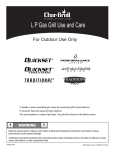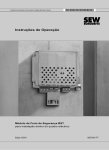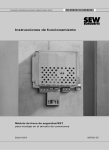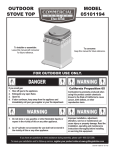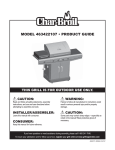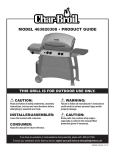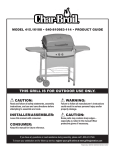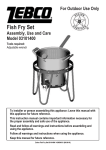Download Char-Broil 04101424 Instruction manual
Transcript
Turkey/Fish Fry Set For Outdoor Use Only Assembly, Use and Care 04101424 Tools required: Phillips screwdriver • Adjustable wrench To installer or person assembling this appliance: Leave this manual with this appliance for future reference. This instruction manual contains important information necessary for the proper assembly and safe use of the appliance. Read and follow all warnings and instructions before assembling and using the appliance. Follow all warnings and instructions when using the appliance. Keep this manual for future reference. Turkey/Fish Fry Set / 42804051 / (08-19-04) DANGER If you smell gas: 1. Shut off gas to the appliance. 2. Extinguish any open flame. 3. If odor continues, keep away from the appliance and immediately call your Fire Department. Failure to follow these instructions could result in fire or explosion which could cause property damage, personal injury or death. DANGER 1. Never operate this appliance unattended. 2. Never operate this appliance within 10 feet or 3 m of any other gas cylinder. 3. Never operate this appliance within 25 feet or 7.5 m of any flammable liquid. 4. Do not fill cooking vessel beyond maximum fill line. 5. Never allow the oil/grease to get hotter than 400°F or 200°C. If the temperature exceeds 400°F (200°C) or if oil begins to smoke, immediately turn the burner or gas supply OFF. 6. Heated liquids remain at scalding temperatures long after the cooking process. Never touch cooking appliance until liquids have cooled to 115°F or 45°C or less. 7. If a fire should occur keep away from the appliance and immediately call your fire department. Do not attempt to extinguish an oil/grease fire with water. Failure to follow these instructions could result in fire or explosion which could cause property damage, personal injury or death. 2 WARNING Combustion by-products produced when using this product contain chemicals known to the State of California to cause cancer, birth defects, or other reproductive harm. Safety Symbols The symbols and boxes shown below explain what each heading means. Read and follow all of the messages found throughout the manual. DANGER DANGER: Indicates an imminently hazardous situation which, if not avoided, will result in death or serious injury. WARNING WARNING: Indicates a potentially hazardous situation which, if not avoided, could result in death or serious injury. CAUTION CAUTION: Indicates a potentially hazardous situation or usafe practice which, if not avoided, may result in minor or moderate injury. 3 WARNING 1. Never leave the appliance unattended. Keep children and pets away from the appliance at all times. 2. The use of alcohol, prescription or non-prescription drugs may impair the consumer’s ability to properly assemble or safely operate the appliance. 3. This appliance is for OUTDOOR use only. Do NOT use in a building, garage or any other enclosed area. Do NOT use in or on a recreational vehicle or boat. NEVER use this appliance as a heater. 4. When cooking, the appliance must be on a level, stable noncombustible surface in an area clear of combustible material. An asphalt surface (blacktop) may not be acceptable for this purpose. 5. Keep the fuel supply hose away from any heated surfaces. 6. When cooking with oil or grease, the thermometer provided MUST be used. Follow instructions in this manual for proper installation and use of the thermometer. If the thermometer supplied with this appliance has been lost or damaged, a replacement thermometer meeting or exceeding the appliance manufacturer specifications shall be obtained before using the appliance. 7. If the temperature exceeds 400°F (200°C) or if oil begins to smoke, immediately turn the burner or gas supply OFF and wait for the temperature to decrease to less than 350°F (175°C) before relighting burner according to the manufacturer’s instructions. If there is a lid (cover), do not remove the lid. 8. In the event of an oil/grease fire immediately call the fire department. Do not attempt to extinguish with water. When cooking with oil/grease, have a Type BC or ABC fire extinguisher readily available. A Type BC or ABC fire extinguisher may, in some circumstances, contain the fire. 9. Never overfill the cooking vessel with oil, grease or water. Follow instructions in this manual for establishing proper oil, grease or water levels. 10. Introduction of water or ice from any source into the oil/grease may cause overflow and severe burns from hot oil and water splatter. When cooking with oil/grease, all food products MUST be completely thawed and towel dried before being immersed in the cooking vessel. 11. Do not place empty cooking vessel on the appliance while in operation. Use caution when placing anything in cooking vessel while the appliance is in operation. 12. In the event of rain, snow, hail, sleet or other forms of precipitation while cooking with oil/grease, cover the cooking vessel immediately and turn off the appliance burners and gas supply. Do not attempt to move the appliance or cooking vessel. 13. Do not move the appliance when in use. Allow the cooking vessel to cool to 115°F (45°C) before moving or storing. 4 WARNING Installation Safety Precautions • Use appliance only with LP (propane) gas and the regulator/valve assembly supplied. • Installation must conform with local codes, or in their absence with National Fuel Gas Code, NFPA 54/ANSI Z223.1. Handling and storage of LP cylinders must conform to LP Gas Code NFPA/ANSI 58. Appliance is not for use in or on recreational vehicles or boats. • This appliance is safety certified for use in the United States only. Do not modify for use in any other location. Modifications will result in a safety hazard. • This appliance shall be used only outdoors and shall not be used in a building, garage or any other enclosed area. • Use appliance at least 10 ft. from any wall or surface. Maintain 10 ft. clearance to objects that can catch fire or sources of ignition such as pilot lights on water heaters, live electrical appliances, etc. Never use under balconies made of wood or ANY overhead construction. • Apartment Dwellers: Check with management to learn the requirements and fire codes for using an LP Gas appliance at an apartment. If allowed, use outside on the ground floor with a ten (10) foot clearance from walls or rails. • Before opening LP tank valve, check the coupling nut for tightness. When appliance is not in use, turn off control knob and LP tank valve. • Never move appliance while in operation or still hot. • If you notice grease or other hot material dripping from appliance onto valve, hose or regulator turn off gas supply at once. Determine the cause, correct, clean and inspect valve, hose and regulator before continuing. Perform a leak test. • The regulator may make a humming or whistling noise during operation. This will not affect safety or use of appliance. • Clean and inspect the hose before each use of the appliance. If there is evidence of abrasion, wear, cuts or leaks, the hose must be replaced prior to the appliance being put into operation. 5 WARNING • Never use a cooking vessel larger than 30 qts. and taller than 15½ inches. • Never fill pot above upper fill line. Oil can splatter causing staining or discoloration to ground surface. • Never leave the appliance unattended. Keep children and pets away from the appliance at all times. • Never place empty cooking vessel on the appliance while in operation. Use caution when placing anything in the cooking vessel while the appliance is in operation. • Never move the appliance when in use. Allow the cooking vessel to cool before moving or storing. • This appliance is not intended for and should never be used as a heater. 24” WARNING: Hose is a trip hazard. • Never operate appliance with LP tanks out of correct position specified in assembly instructions. • Always close LP tank valve and remove coupling nut before moving LP tank from specified operating position. • Appliance shall not be used for commercial cooking. • This appliance will be hot during and after use. Use insulated oven mitts or gloves for protection from hot surfaces or cooking liquids. • Avoid bumping of or impact with the appliance to prevent spillage or splashing of hot cooking liquid. • Never drop food or accessories into hot cooking liquid. Lower food and accessories slowly into the cooking liquid in order to prevent splashing or overflow. When removing food from the appliance care should be taken to avoid burns from hot cooking liquids. 6 DANGER • The safety relief valve on the LP tank could activate releasing gas and cause an intense fire with risk of death or serious injury. Therefore, follow instructions bulleted below exactly. • NEVER store a spare LP tank under or near appliance or in enclosed areas. • NEVER fill the cylinder beyond 80% full. An overfilled spare LP tank is hazardous due to the possible gas released from the safety relief valve. • If you see, smell, or hear escaping gas, immediately get away from the LP tank/appliance and call your fire department. • All spare LP tanks must have safety caps installed on the LP tank outlet. LP Tank Removal, Transport and Storage • Turn OFF all control knobs and LP tank valve. Turn coupling nut counterclockwise by hand only — do not use tools to disconnect. Install safety cap onto LP tank valve. Always use cap and strap supplied with valve. Failure to use safety cap as directed may result in serious personal injury and/or property damage. • A disconnected LP tank in storage or being transported must have a safety cap installed (as shown). Do not store an LP tank in enclosed spaces such as a carport, garage, porch, covered patio or other building. Never leave an LP tank inside a vehicle which may become overheated by the sun. LP Tank Valve Safety Cap Retainer Strap • Do not store LP tanks in an area where children play. LP Tank The LP tank used with your appliance must meet the following requirements: • Purchase LP tanks only with these required measurements: 12” (30.5cm) (diameter) x 18” (45.7cm) (tall) with 20 lb. (9 kg.) Capacity maximum. • The LP tank must be constructed and marked in accordance with specifications for LP tank of the U.S. Department of Transportation (DOT). See LP tank collar for marking. 7 LP tank valve must have: • Type 1 outlet compatible with regulator or appliance. • Safety relief valve. • UL listed Overfill Protection Device (OPD). This OPD safety feature is identified by a unique triangular hand wheel. Use only tanks equipped with this type of valve. OPD Hand Wheel LP tank must be arranged for vapor withdrawal and include collar to protect LP tank valve. LP (Liquefied Petroleum Gas) • LP gas is non toxic, odorless and colorless when produced. For Your Safety, LP gas has been given an odor (similar to rotten cabbage) so that it can be smelled. • LP gas is highly flammable and may ignite unexpectedly when mixed with air. LP Tank Filling • Use only licensed and experienced dealers. • LP dealer must purge tanks before filling. • Dealer should NEVER fill LP tank more than 80% of LP tank volume. Volume of propane in tanks will vary by temperature. • A frosty regulator indicates gas overfill. Immediately close LP tank valve and call local LP gas dealer for assistance. • Do not release liquid propane (LP) gas into the atmosphere. This is a hazardous practice. • To remove gas from LP tank, contact an LP dealer or call a local fire department for assistance. Check the telephone directory under “Gas Companies” for nearest certified LP dealers. LP Tank Exchange • Many retailers that sell appliances offer you the option of replacing your empty LP tanks through an exchange service. Use only those reputable exchange companies that inspect, precision fill, test and certify their cylinders. Exchange your tank only for an OPD safety feature-equipped tank as described in the “LP Tank” section of this manual. • Always keep new and exchanged LP tanks in upright position during use, transit or storage. • Leak test new and exchanged LP tanks BEFORE connecting to appliance. 8 LP Tank Leak Test For your safety • Leak test must be repeated each time LP tank is exchanged or refilled. • Do not smoke during leak test. • Do not use an open flame to check for gas leaks. • Appliance must be leak checked outdoors in well-ventilated area, away from ignition sources such as gas fired or electrical appliances. During leak test, keep appliance away from open flames or sparks. Use a clean paint brush and 50/50 soap and water solution. Use mild soap and water. Do not use household cleaning agents. Damage to gas train components can result. Brush soapy solution onto all weld seams and entire valve area. WARNING If “growing” bubbles appear, do not use or move the LP tank. Contact an LP gas supplier or your fire department. Connecting Regulator to the LP Tank 1. Place LP tank on a secure, level, and stable surface. Off Clockwise 2. Turn control knob to the OFF position. OPD Hand Wheel 3. Turn LP tank OFF by turning hand wheel clockwise to a full stop. Type 1 outlet with thread on outside. 4. Remove the protective cap from the LP tank valve. Always use cap and strap supplied with valve. Safety Relief Valve Strap and cap A 9 Do not use a POL transport plug (A) (plastic part with external threads)! It will defeat the safety feature of the valve. 5. Hold regulator, insert nipple (B) into LP tank valve. Hand tighten coupling nut, holding regulator in a straight line (C) with LP tank valve so as not to cross thread the connection. Nipple must be centered into the LP tank valve. Str C aig B ht Hold coupling nut and regulator as shown for proper connection to LP tank valve. 6. Turn the coupling nut clockwise to tighten to a full solid stop. The regulator will seal on the back-check feature in the LP tank valve, resulting in some resistance. An additional one-half to three quarters turn is required to complete connection. Tighten by hand only — do not use tools. NOTE: If you cannot complete connection, disconnect regulator and repeat steps 5 and 6. If you are still unable to complete the connection, do not use this regulator! WARNING • Do not insert any tool or foreign object into the valve outlet or safety relief valve. You may damage the valve and cause a leak. Leaking propane may result in explosion, fire, severe personal injury, or death. • Never attempt to attach this appliance to the self-contained LP gas system of a camper or trailer or motor home. 10 WARNING • Do not use appliance until leak checked. • If leak is detected at any time, STOP. • If you cannot stop a gas leak, immediately close LP tank valve, leave area of appliance, and call LP gas supplier or your fire department! Leak Testing Valves, Hoses and Regulator 1. Turn all control knob(s) to OFF. 2. Be sure regulator is tightly connected to LP tank. A 3. Completely open LP tank valve by turning hand wheel counterclockwise. If you hear a rushing sound, turn gas off immediately. There is a major leak at the connection. Correct before proceeding. 4. Brush soapy solution onto indicated connections shown at right in A and B. (Reference connection of hose to burner on page 15.) B 5. If “growing” bubbles appear, there is a leak. Close LP tank valve immediately and retighten connections. If leaks cannot be stopped, do not try to repair. Call for replacement parts. Order new parts by giving the serial number, model number and name of items needed to the Warranty Service Center at 1-800-232-3398. Use only replacement parts specified by manufacturer. 6. Always close LP tank valve after performing tank leak test by turning hand wheel clockwise. WARNING • This device is equipped with a remote electronic ignition system that can become inadvertently activated by another electronic device, causing a spark. • Do not store in an area where flammable fumes can accumulate and ignite. 11 Lighting Instructions Do not lean over LP cooker while lighting. 1. Turn regulator control valve to OFF position. 2. Fully open LP tank valve. 3. Slowly turn ON the regulator control valve. Push transmitter button or button on receiver. If ignition does not occur, light a match and place it over burner. Slowly turn ON regulator control valve. DO NOT stand with head or arms over cooker. 4. If ignition does not occur in 5 seconds, turn the burner control(s) off, wait 5 minutes, and repeat the lighting Procedure. Curing of paints and parts will produce an odor only on first use. Ignitor Button CAUTION If burner does not light OR if burner flame is accidentally extinguished, turn knob to OFF, wait 5 minutes, try again. If the burner does not ignite with valve open OR if burner flame is accidentally extinguished after lighting, gas will continue to flow out of the burner and could accidentally ignite with risk of injury. Burner Flame Check • Light burner, rotate knob from HIGH to LOW. You should see a smaller flame in LOW position than seen on HIGH. Always check flame prior to each use. The air damper (D) mounted on the back of your burner helps to control the amount of primary air that mixes with the LP gas. A blue flame with little or no yellow flame provides the best heat. Adjust the air damper by turning it clockwise or counterclockwise until the desired flame is achieved. Turning LP Cooker Off • Turn all knobs to OFF position. Turn LP tank OFF by turning hand-wheel clockwise to a full stop. Bad Good Yellow Yellow Blue Blue Holes in Burner D Air Damper 12 Hose Check •Before each use, check to see if hoses are cut or worn. Replace damaged hose assembly before using appliance. Use only valve/hose/regulator specified by manufacturer. Cleaning the Burner WARNING Spiders’ nests or wasps’ mud inside the burner may cause fire at the air damper. If a fire occurs, immediately turn off gas supply at LP tank valve. (See representative illustration in Fig. 1) NOTE: Spiders and small insects can spin webs and build nests inside the burner. This especially occurs in late summer and fall before frost when spiders are most active. These nests can obstruct gas flow and cause a fire in and around the burner and orifice. Such a fire can cause operator injury and serious damage to the appliance. To help prevent a blockage and ensure full heat output, clean and inspect burner tube often (once or twice a month). NOTE: Water or air pressure will not normally clear a spider web, Steps for Cleaning the Burner: 1. Remove orifice/hose from the burner. 2. Look inside the burner tube for nests, webs, or mud. 3. To remove the above obstructions, use an accessory flexible venturi brush or bend a small hook on one end of a long flexible wire such as the one shown in Fig. 2. 4. Inspect and clean the burner if needed. 5. Reattach orifice/hose to burner. 13 Cleaning and Maintenance • • • • • • • • Keep appliance area clear and free from materials that burn. Do not block holes in bottom or sides of appliance. Check burner flames regularly. Use appliance only in well-ventilated space. NEVER use in enclosed space such as carport, garage, porch, covered patio, or under ANY overhead construction. Completely thaw meat and poultry prior to placing in hot oil. To minimize splattering, dry surfaces of meat and poultry prior to placing in hot oil. When LP tank is connected to appliance, store outdoors in well-ventilated space and out of reach of children. Store appliance indoors ONLY if LP tank is turned off and disconnected, removed from appliance and stored outdoors. CAUTION All cleaning and maintenance should only be done when the appliance is cool and with the fuel supply turned off at the LP tank. DO NOT clean any part in a self-cleaning oven. The extreme heat will damage the finish. Correct care and maintenance will keep your appliance operating smoothly. Clean regularly as determined by the amount of use. NOTE: Clean the entire appliance each year and tighten all hardware on a regular basis (1–2 times a year or more depending on usage). Cleaning should be done where detergents won’t harm patio, lawn or the like. Suggested Cleaning Materials: • Mild dish washing liquid detergent • Wire brush • Nylon cleaning pad • Hot water • Paper clip • Soft brass bristled brush Component Cleaning: • Burner: Wire brush loose corrosion from burner exterior. Clean clogged gas port holes with an opened paper clip. Replace corroded or damaged burners that would emit excess gas. • Cooking surfaces, pots and pans: Clean the cooking surface with soapy water and a nylon cleaning pad. 14 Assembly Instructions Burner 1. Insert the burner into the cooker stand and through the cut-out opening in the side of the stand. 2. Insert the threaded pin on the bottom of the burner into the center hole in the burner bracket. Make sure the alignment pin is seated in the notch on the edge of the burner bracket. Alignment Pin Threaded Pin 3. Place the heat shield beneath the burner bracket, aligned with the burner pins, and secure with the #10-24 hex nut (keps). Nut Heat Shield 4. Place the damper over the end of the burner. Insert the brass hose fitting into the small end of the spring, then thread brass fitting into the burner and tighten. Be sure not to strip threads on brass fitting. DO NOT OVERTIGHTEN. Proper connection is critical for correct operation of unit. 15 Damper Spring Hose 5. Thread wire hook through hole on side of regulator. 6. When transporting or storing LP cooker without tank attached, hook regulator onto burner or cooker stand to prevent damage to regulator. MODULE BATTERY INSTALLATION. (Batteries not included.) 7. Locate Electronic Receiver Module. 8. Remove four screws from back of module. Front of module. Back of module. 16 CAUTION A jumper wire is attached to receiver terminals to prevent shock during battery installation and receiver attachment to stand. Do not remove jumper wire until step 11 is completed. 9. Place module on flat surface and remove front cover. Insert two AAA batteries and reassemble front ensuring that the rubber gasket remains in place. Secure with four screws removed in step 2 . Make sure rubber gasket remains in place. (2 AAA) + - + Electrode/Ignitor Assembly Instructions 10. Insert the electrode into the side of the cooker stand, behind the ignitor panel. Secure the electrode and the Ground wire to the stand with one #10x1/2” self-tap screw. Ground wire terminal must be between electrode flange and wall of stand. The end of the electrode wire should be above the edge of the burner. NOTE: Tip of electrode wire should be 1/16”-1/8” from burner for proper ignition. Bend electrode wire slightly if necessary. Electrode Ignitor panel Ground wire Electrode wire Burner Ground wire terminal Electrode flange 17 11. Attach ignitor module to ignitor panel using two #8x1/2” self-tap screws. Ignitor Button must be CAREFULLY pulled through hole in Ignitor panel before fully tightening the screws. Ignition Module Ignitor panel Remove and discard jumper wire on terminals. Keep discarded wire away from small children. Ignitor Button 12. Place the ignitor cover over the ignitor and attach to ignitor panel using two #10x1/2” self-tap screws. 13. The ignitor wire has a flat connector at one end and a round connector at the other end. Push the round connector into the ignitor through the lower left hole in the ignitor cover. Push the flat connector onto the electrode tab. Connect ground wire to right terminal. Attach heat shield to ignitor cover Using two #10x1/2” self-tap screws. Ignitor cover Heat shield screws Flat end Heat Shield Ignitor wire Left terminal Ground wire 18 TRANSMITTER BATTERY INSTALLATION (Batteries not included). Use a small screwdriver or paperclip to open battery door. + Using Your Thermometer Check the thermometer before each use by inserting into a pot of boiling water and ensuring that it registers approximately 212°F +/– 20°F (100°C +/– 10°C). If it does not function properly, obtain a replacement that meets or exceeds the manufacturer’s specifications before using the appliance. Prior to lighting, position thermometer clip so that at least 1/2” of thermometer tip is submerged in oil. Reposition thermometer as necessary to cook. Continue to use thermometer until burner is turned off. 19 + (2 AAA) WARNING Inside this area remote ignitor may inadvertently be started by T.V. Remotes, garage door openers, remote controlled toys, remote car alarms, etc. Keep children and pets away from the appliance at all times. Receiver Box 3" 7’ 130"’ . 20 The following safety measures are recommended when using your fry set. LOCATION MATTERS Select a safe place to fry your turkey. It should be in an open area, outside, and on a cement or brick surface. Place the liquid propane gas tank and fryer so that any wind blows the heat of the fryer away from the gas tank. Never use your fryer in an enclosed area, near a wall or on a wooden deck. Keep a minimum clearance of 10 feet from the sides, front and back of the fryer to any construction. PREPARE PROPERLY • Remove and discard any thermometer buttons, leg holders and giblet packs contained inside the completely thawed turkey. Do not attempt to fry a frozen or partially frozen turkey. Ensure your turkey is completely thawed prior to proceeding. The USDA recommends thawing 24 hours (1 day) for every 4-5 pounds in a refrigerator. • Insert the stainless steel turkey lifter up through the cavity so that the legs are at the top. 21 Determining the maximum fill level when using a pot without a maximum fill line: • Place the turkey (or other food product) on the lifter. • Place the turkey and lifter into the empty pot. • Fill the pot with water just until the turkey is completely submerged. There must be a minimum of 3 inches or 8 cm between the water level and top of the pot. • Remove the turkey from the pot and either mark the water level on the side of the pot or measure the amount of water in the pot. • Remove the water and completely dry the pot and the turkey. • This is the amount of peanut oil the pot is to be filled with to cook the turkey. • Use marinade by injecting it into the thicker areas of the turkey breasts and thighs. • To use, load the injector with marinade and insert the needle into the turkey. Withdraw the needle slowly while pushing the plunger, minimizing large pockets of marinade and spreading it more evenly. Discard any unused marinade. 22 • Completely pat dry the inside and outside surfaces of the turkey. This is very important as it reduces the splattering of oil. After patting the bird dry, add herb rubs or seasonings to the skin. FRY WITH CARE • Check your hose at both ends for proper connection. Also, place the tank and hose so that they are not located directly next to the fryer (see photo). Center the pot over the burner on the cooker. • Fill the pot to the mark with peanut oil. Remove the butcher’s tape from the pot. DANGER • Do not fill past the maximum fill line marked on the utensil. • An oil overflow may occur resulting in a fire which could cause property damage, personal injury or death. Follow directions above to prevent this. 23 • Light the burner unit and heat the oil to 325° F. Never leave the fryer unattended at any time. • Check the oil using a deep fry temperature gauge. If it has reached 325° F, you are ready to start deep frying. Monitor the temperature throughout the frying process to maintain 325° F — never let the oil temperature get hotter than 325° F. • If the oil exceeds 400° F or if the oil begins to smoke, immediately turn the burner off. • Wear long, insulated, flame-retardant gloves to protect your hands and arms. Use the lift handle to slowly lower the turkey into the oil. Pause at several points before reaching the bottom of the pot. • Adjust the burner to maintain 325° F. Monitor the fryer during the entire process to assure a safe frying experience. Do not leave fryer unattended. • Cook until a golden brown color is achieved. Normal cooking time is 3½ minutes per pound. 24 • Remove the turkey from the oil and place it on paper towels in an aluminum pan. • Using a meat thermometer, check for an internal meat temperature of 180° F. • Remove turkey fry accessory and allow the turkey to “rest” for 15 minutes to allow the juices to settle into the turkey. Slice and serve! Limited Warranty Manufacturer warrants this Fry Set for replacement or repair of parts and/or workmanship for a period of 3 months. Paint is not warranted and may require touch-up. Items considered to be consumable such as batteries are not covered under these warranties. These limited warranties are made exclusively to the original consumer presenting proof of purchase. These warranties are limited to non-commercial residential use only. Any returned goods must be shipped prepaid. These warranties do not cover normal wear and tear or damages resulting from abuse or misuse. This warranty excludes incidental or consequential cost due to damages or losses to persons or property of any nature. NOTICE: Some states do not allow the exclusion or limitation of incidental or consequential damages or limitations on how long an implied warranty lasts, so the above limitations or exclusions may not apply to you. This warranty gives you specific legal rights and you may also have other legal rights which may vary from state to state. For further information or replacement parts, contact manufacturer, toll free at 1 (800) 232-3398. 25 26 (If you register online, you do not need to send in this registration card.) Please register your grill online at: WWW.GRILLREGISTRATION.COM 27 Troubleshooting • Electronic Ignition System Problem Possible Cause Solution No spark using transmitter. • Push button on receiver. • If electrode sparks, troubleshoot transmitter. If electrode does not spark, troubleshoot receiver. • Transmitter out of range. • Reposition transmitter. • Receiver window blocked. • Check for obstructions between transmitter and receiver. • Make sure electrode is within 1/16”-1/8” of burner without touching burner. • Electrode not in correct position. No spark using Receiver Module. • Loose electrode wire. • Make sure electrode wire secured tightly to electrode. • Batteries installed incorrectly. • Make sure that the batteries Are installed Correctly. • Dead batteries. • Replace batteries. • Faulty transmitter. • Replace Transmitter. • Transmitter out of range. • Reposition transmitter. • Receiver window blocked. • Check for obstructions between transmitter and receiver. • Make sure electrode is within 1/4” of burner without touching burner. • Electrode not in correct position. • Loose electrode wire. • Make sure electrode wire secured tightly to electrode. • Batteries installed incorrectly. • Make sure that the batteries are installed correctly. • Dead batteries. • Replace batteries. • Faulty Module. • Replace transmitter. 28 STOP! Missing a part? No need to go back to the store! The store where you made your purchase does not stock parts for this item. If you need parts, whether they are missing or damaged, call the Customer Service toll free Help Line. Call Our Help Line Call us and we will gladly ship the part you need FREE OF CHARGE. PARTS LIST ITEM DESCRIPTION 55700394 55700460 42000028 55700577 55700578 55700579 55700580 40011308 55700403 33200089 BURNER KIT SPRING & VENT KIT HARDWARE BAG ELECTRONIC RECEIVER/IGNITION KIT ELECTRODE KIT ELECTRONIC RECEIVER MOUNTING KIT ELECTRONIC RECEIVER HEAT SHIELD KIT OUTER CARTON, 04101424 30 QT ANODIZED POT W/POUR SPOUT AND 12” GLASS LID COOKER STAND 3/8” WIRE 41201241 STAINLESS STEEL TURKEY FRY T-STAR 41201242 STAINLESS STEEL T-STAR LIFTING HANDLE 29100560 43302827 41213000 41201236 42804051 29 ELECTRONIC TRANSMITTER ASSEMBLY HEAT SHIELD HVR ASSEMBLY LONG STEM THERMOMETER ASSEMBLY INSTRUCTIONS W/PARTS LIST QTY 1 1 1 1 1 1 1 1 1 1 1 1 1 1 1 1 1 Should you encounter any problem CALL US FIRST. Do not return this product to the store. WE CAN HELP. 24 Hours a Day, 7 Days a Week 1-800-232-3398 To insure your satisfaction and for follow-up service, register your product online at: www.grillregistration.com Tools required for assembly: Phillips screwdriver • Adjustable wrench W.C. Bradley Company Columbus, GA 31902 All Rights Reserved































